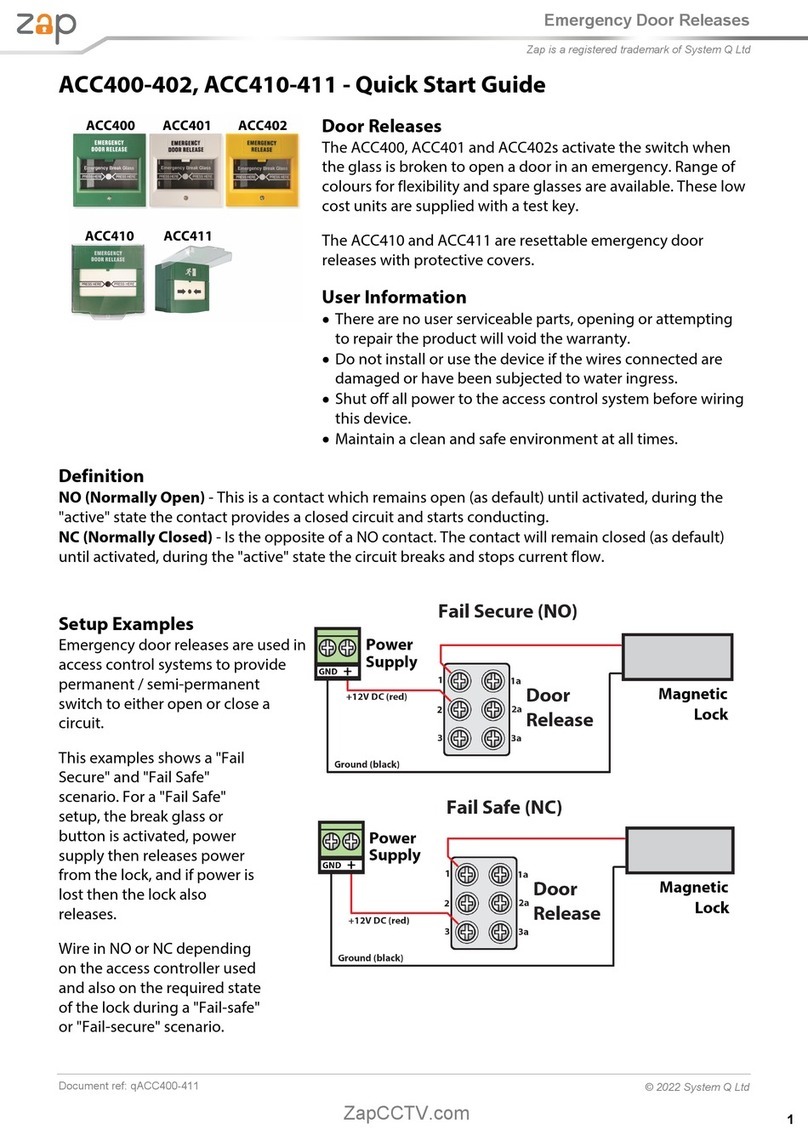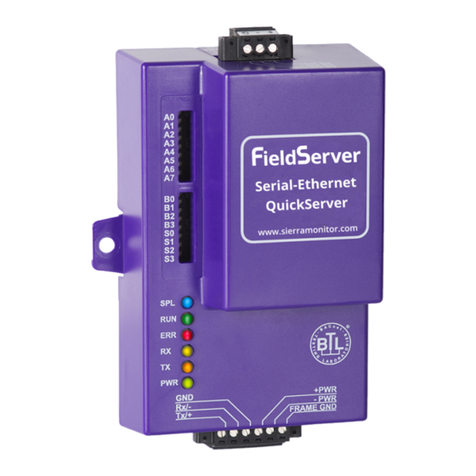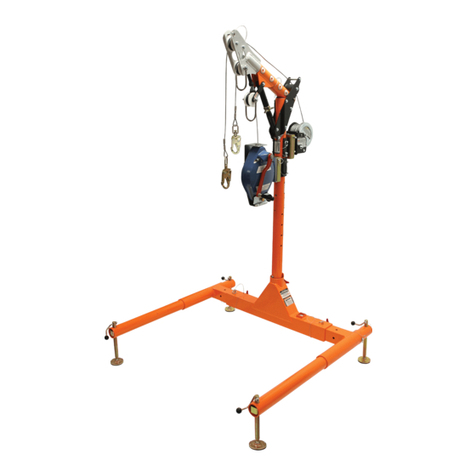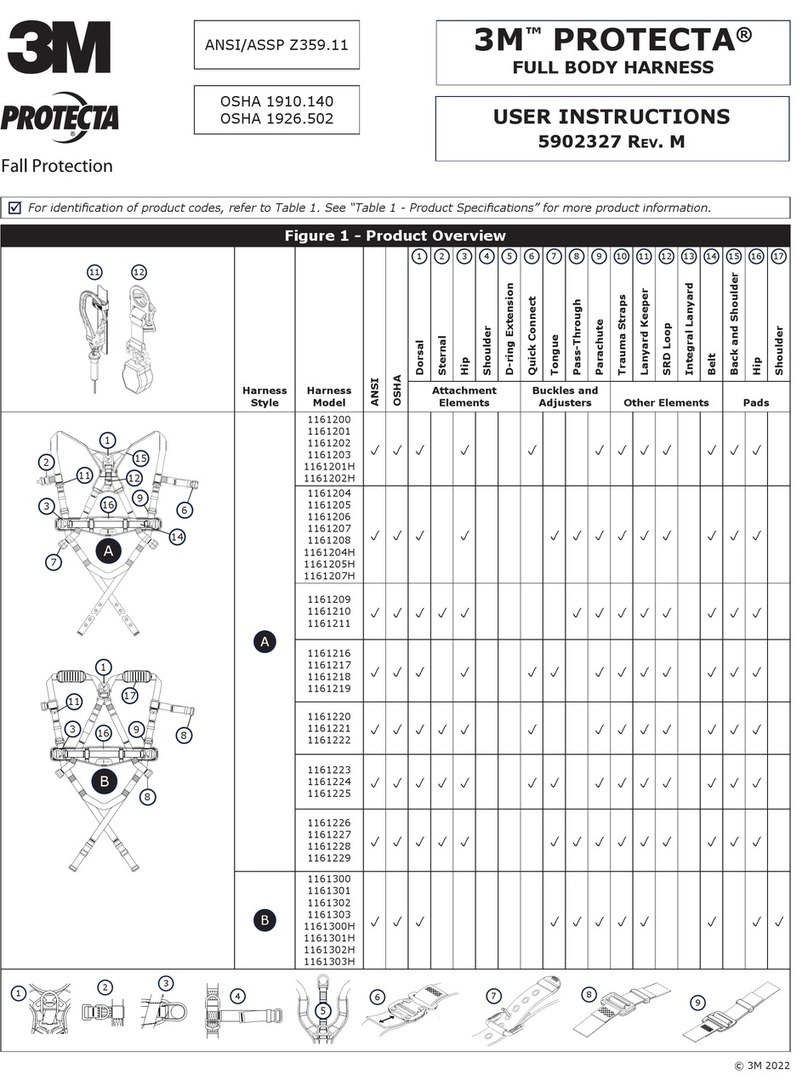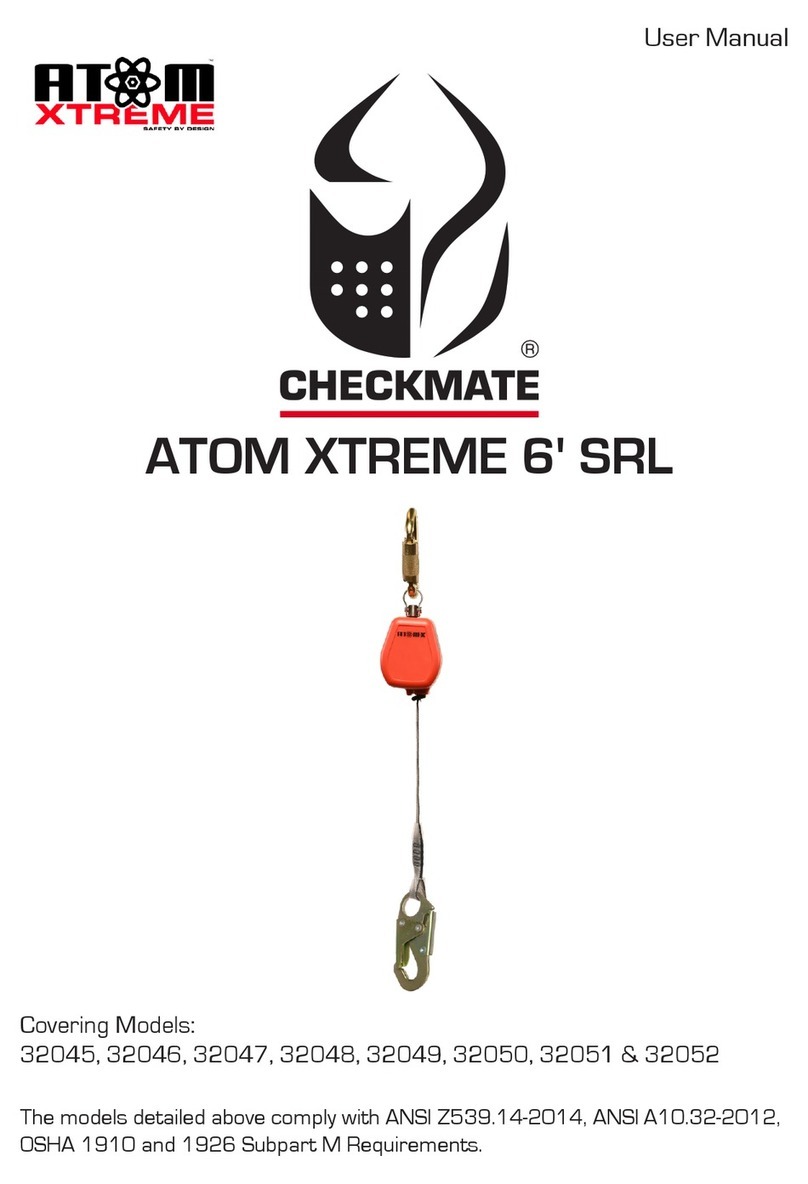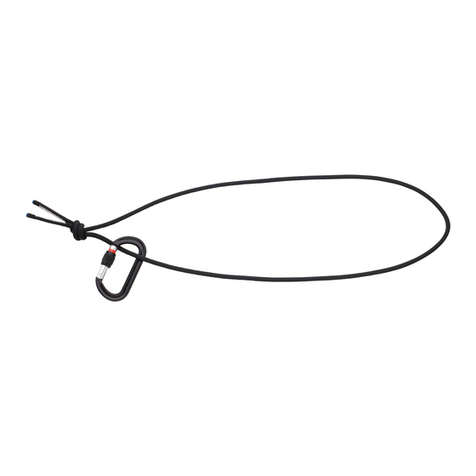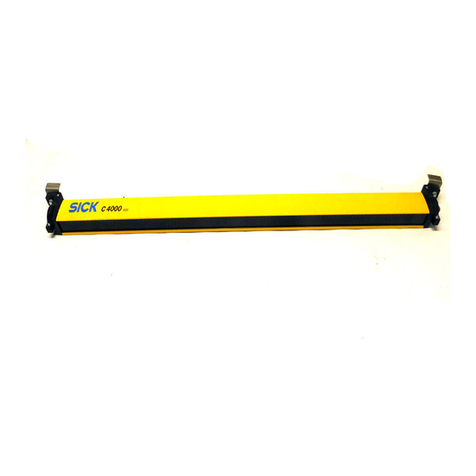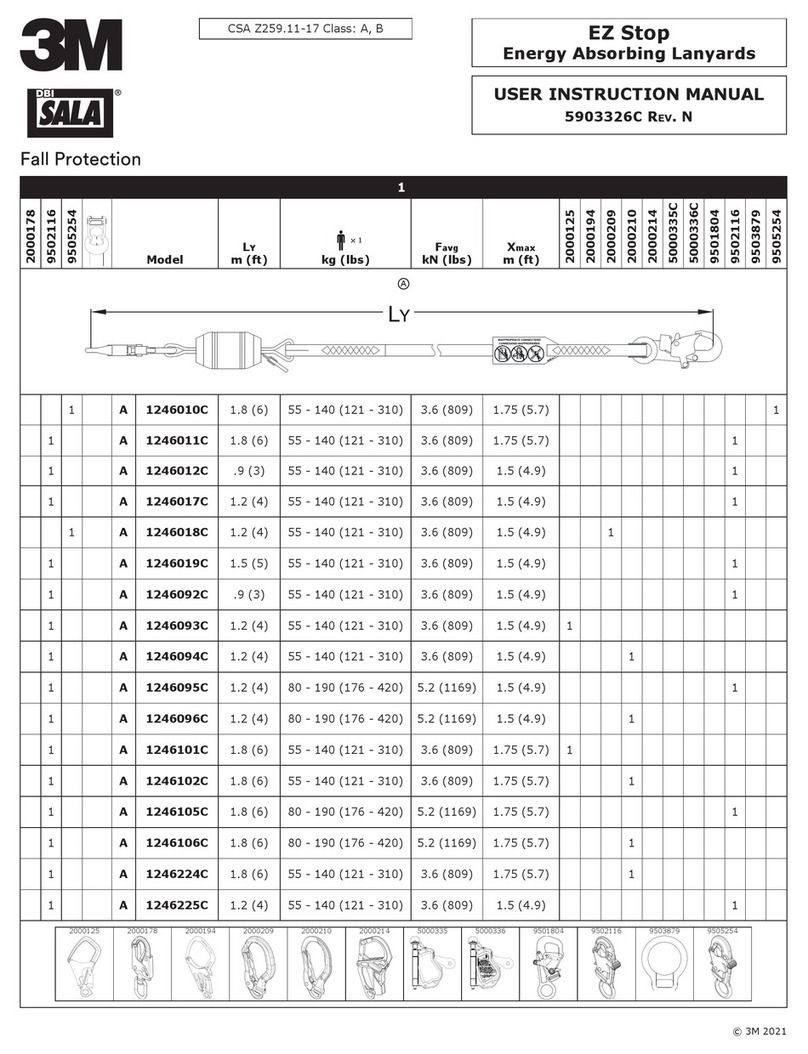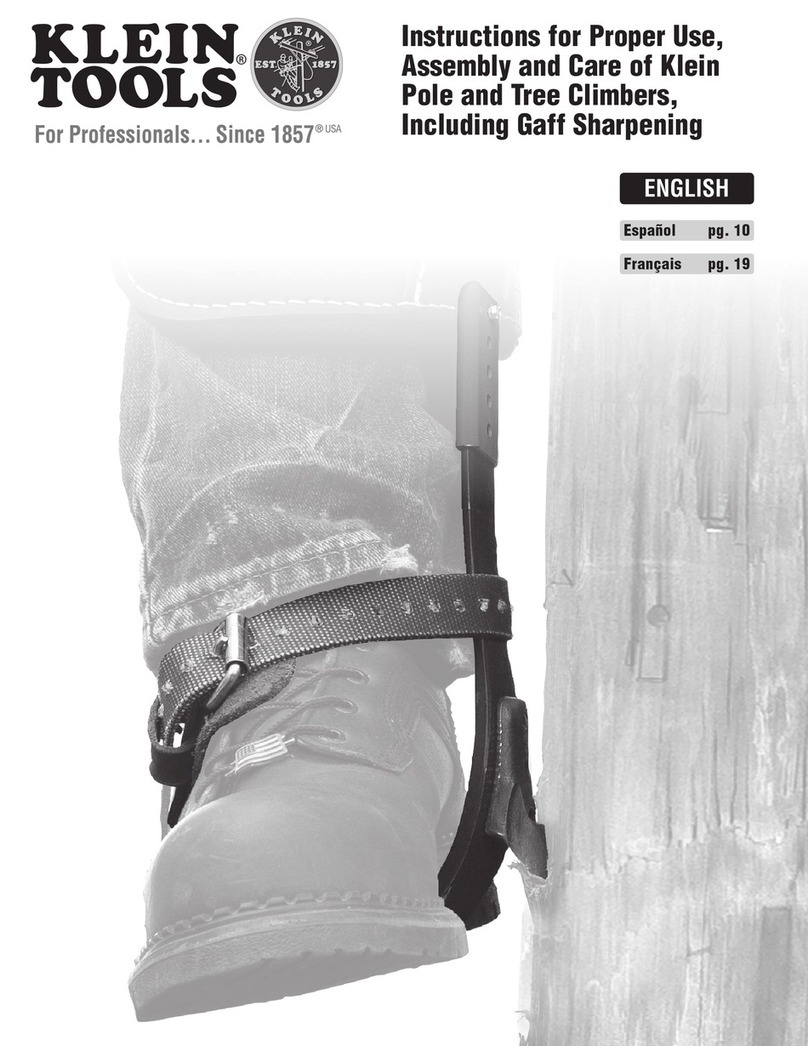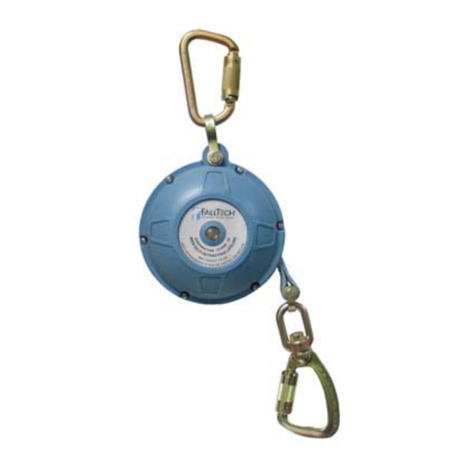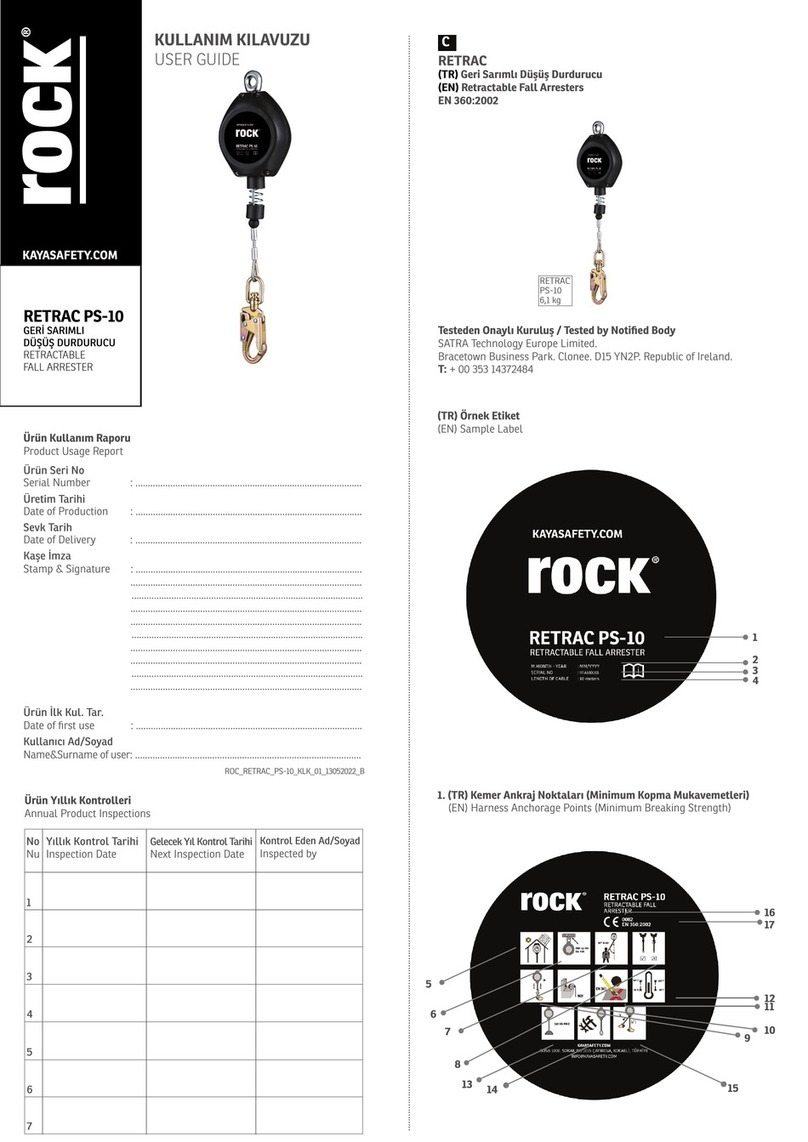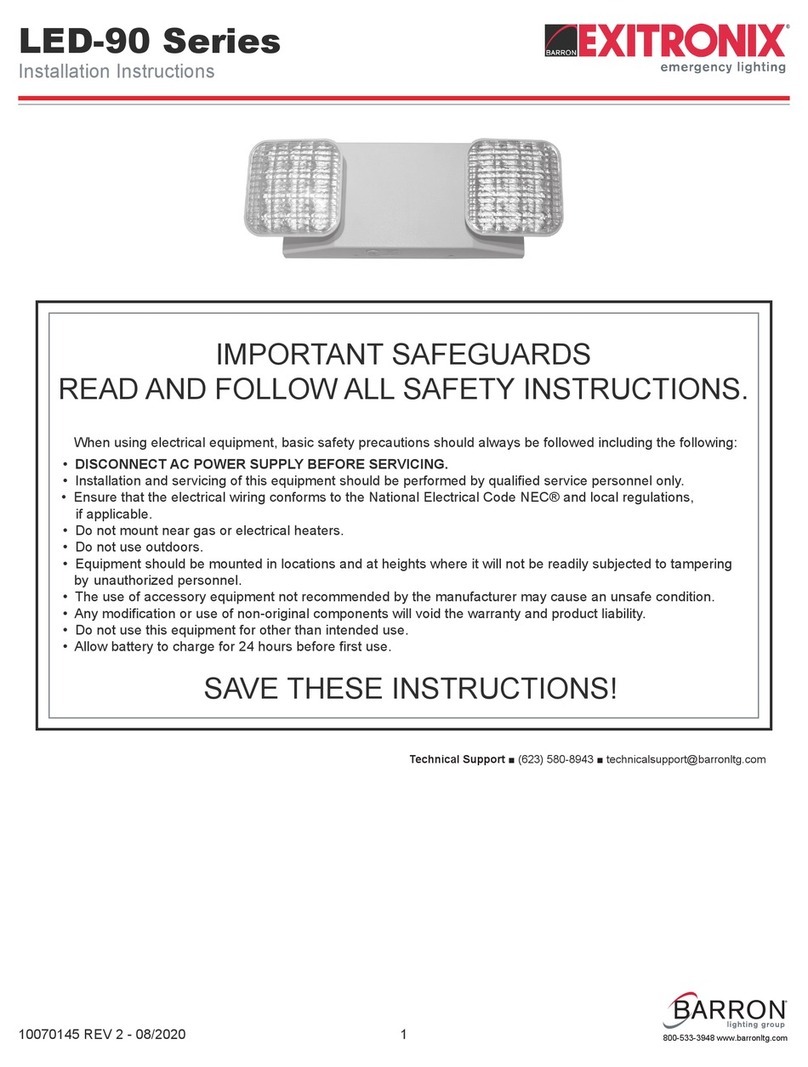Du Pont Tychem User manual

Garment User Manual
Applies to:
DuPont™ Tychem®Vapor
Protective Level A Garments
DuPont™ Tychem®Encapsulated
Level B Garments
NFPA Compliant
DuPont™ Tychem®Garments
Certied to NFPA 1991 or NFPA 1994, Class 2
This information packet may not be removed except by the end user
Revised August, 2016

2
User Manual for DuPont™Tychem®Encapsulated Level A and Encapsulated Level B Suits
Contents
Safety Considerations .....................................................3
Wearer Qualications......................................................3
Encapsulating Design Garments ......................................3
Breathing Air Requirements for Encapsulating
Design Garments ............................................................4
Other Personal Protective Equipment...............................4
Respirators .................................................................... 4
Over Covers.................................................................... 4
Footwear........................................................................ 4
Gloves ........................................................................... 4
Garment Inspection, Maintenance, and Testing................5
Garment Inspection........................................................ 5
Garment Inspection Steps .............................................. 5
Table 1: Garment Maintenance Schedule ........................ 5
Cleaning ........................................................................ 6
Pressure Testing Level A Tychem®Garments.................... 6
Closure Lubricants.......................................................... 7
Garment Repair.............................................................. 7
Glove Replacement ........................................................ 7
Recommended Duration of Use........................................7
Storage Conditions......................................................... 8
Sizing Considerations .....................................................8
Donning Encapsulating Level A and B Garments ..............8
Dong Encapsulating Level A and B Garments.................9
Field Decontamination ....................................................9
Decontamination.............................................................9
Inspection Before Re-use...............................................10
Garment Retirement Considerations ..............................10
Disposal .......................................................................10
Temperature Ranges .....................................................10
Limitations of Use .........................................................10
Wearer Must Be Medically Approved..............................10
Manage and Prevent Heat Stress ...................................11
Chemical Permeation Data.............................................11
Avoid Purposeful Exposure ............................................11
Static Electricity............................................................11
Avoid Exothermic Reactions ..........................................12
Supplied Air Line Limitations.........................................12
Avoid Suocation ..........................................................12
Never Use Pure Oxygen .................................................12
Attached Socks .............................................................12
Communications ...........................................................12
Positive Pressure ..........................................................12
Use of Adhesive Tape to Seal Chemical Garments...........12
Warnings ......................................................................13
Your Responsibility as a User ........................................13
Glossary .......................................................................14
Warranty & Disclaimers.................................................17
Sizing Chart for Fully Encapsulated Suits .......................18
DuPont™Tychem®Garment Inspection and Test Log.......19

3
User Manual for DuPont™Tychem®Encapsulated Level A and Encapsulated Level B Suits
Safety Considerations
IMMEDIATELY STOP WORK IF PERSONAL PROTECTIVE
EQUIPMENT (PPE) FAILS. If any item of the personal
protective equipment ensemble fails during use,
immediately cease work activity, retreat from hazard zone,
safely remove the PPE (may require decontamination
procedure), determine the cause of the PPE failure and re-
evaluate the selection and use of the PPE for that task.
Be sure to read, understand and follow the information in
this manual and all applicable governmental occupation
safety and health statutes. Serious injury or death may occur
from improper use of these garments. These garments must
be selected and used in accordance with applicable personal
protective equipment regulations, which in the United States
is 29 CFR 1910.132. For users of these garments outside
of the United States, consult national or other applicable
personal protective equipment laws and regulations.
Users must read this guide thoroughly and should take the
following precautions into consideration:
• Avoid ame contact. These suits are not intended for
exposure to an open ame; however, Tychem® 10000 FR
(Tychem®Reector®) model RF600T and Tychem®
10000 (Tychem®TK) models TK600T and TK601T (worn
with over cover provided) have been tested and certied
to the ash re escape option of NFPA 1991, Standard
on Vapor-Protective Ensembles for Hazardous Materials
Emergencies.
• Do not knowingly enter an environment in which the
concentration of ammable gas/vapor or combustible
dust is within ammable or explosive limits when
wearing a Tychem®garment, including RF600T, TK600T,
and TK601T. Retreat immediately if you encounter such
an environment.
• No Tychem®garment, including RF600T, TK600T, and
TK601T, is intended for re-ghting activities, nor for
protection from hot liquids, steam, molten metals,
welding, or thermal radiation. However, Tychem®
6000 FR (Tychem®ThermoPro) fabric was tested to
EN ISO 11612:2015 (Protective clothing — Clothing
to protect against heat and ame — Minimum
performance requirements) and was rated as Class D1
for molten aluminum and Class E2 for molten iron.
• Good practice is to minimize, as much as possible,
continuous exposure to any known hazardous
substance.
• If you develop any of the following symptoms while you
are wearing a Tychem®garment immediately leave the
contaminated area, undergo eld decontamination, and
remove (doff) the garment:
Fever Unusual odor or taste
Difculty breathing Eye or skin irritation
Nausea Narrowing or dimming of vision
Excessive Tiredness Claustrophobia
Dizziness Loss of balance or orientation
Numbness
Tychem®garments will not protect the wearer in all
situations and environments or protect the wearer from
all hazardous materials. A trained and qualied safety
professional must select the chemical protective clothing
and other PPE based on a hazard assessment. It is your
responsibility as a user of this garment to determine
the level of exposure and the proper personal protective
equipment needed. Many performance properties cannot
be tested by the users in the eld. Refer to DuPont™
SafeSPEC™(www.safespec.dupont.com) for information
regarding performance data for Tychem®Level A and Level B
Encapsulating suits.
Wearer Qualications
Do not wear these garments unless you are properly trained
in their use. You must be in good physical condition to wear
these garments. Consult a physician before donning one of
these garments to ensure you are capable of wearing these
garments and all required respiratory equipment under the
expected work conditions and environment.
Encapsulating Design Garments
Per EPA/OSHA guidelines, encapsulating suits may be
considered either Level A or Level B. Encapsulating
garments that pass the ination test described in ASTM
F1052, Standard Test Method for Pressure Testing Vapor
Protective Ensembles, are considered Level A. Encapsulating
garments that are not designed to pass ASTM F1052 are
considered Level B.

4
User Manual for DuPont™Tychem®Encapsulated Level A and Encapsulated Level B Suits
Breathing Air Requirements for Encapsulating
Design Garments
Encapsulating garments are designed to completely cover
the wearer, including all respiratory equipment (except
for external air supply lines, if applicable). Encapsulating
garments require that fresh breathing air be supplied to the
wearer at all times.
CAUTION: YOU MUST USE AN OPEN CIRCUIT SELF-
CONTAINED BREATHING APPARATUS OR AIR-LINE
SUPPLIED RESPIRATOR WITH ALL ENCAPSULATING
GARMENTS.
Other Personal Protective Equipment
To help protect you while wearing a Tychem®garment, the
use of other personal protective equipment (PPE) items
is often required based on the hazard assessment. PPE
selection must be conducted by a trained and experienced
safety professional. Additional protective equipment may be
required to deal with hazards such as, but not limited to, the
following:
• Flammable or Explosive Environment
• Extreme Heat (Heat Stress)
• Extreme Cold (Hypothermia)
• Physical Hazards (Sharps, Puncture, Rough Surfaces,
Falling Debris)
• Slipping Hazards
• Visibility Requirements
• Fall Protection
• Contamination Avoidance
Respirators
Tychem®encapsulating suits must be worn with a full
face, supplied air respirator. The user must be trained and
physically t to use a respirator. The performance of your
respirator must be veried with a performance based t
test. Failure to properly select, test, use and maintain your
respirator can result in serious injury or death. The selection
of the appropriate respirator is the responsibility of the
safety professional or industrial hygienist.
The full face, supplied air respirator worn with encapsulating
Level A or Level B Tychem®garments must include:
• An open circuit, self-contained breathing apparatus
(SCBA) certied as compliant with NFPA 1981,
“Standard on Open-Circuit Self-Contained Breathing
Apparatus for Fire Service“
or
• An external, breathing air-quality, air-line system with
garment pass-through and escape bottle.
Do not wear a closed-circuit (rebreather-type) SCBA with
Tychem®encapsulating Level A or encapsulating Level B
garments. Do not wear an air-purifying respirator (APR) or
a powered, air-purifying respirator (PAPR) inside a Tychem®
encapsulating Level A or encapsulating Level B suit.
Over Covers
Use of the provided over cover is required to be worn with
Tychem® 10000 (Tychem®TK) models TK600T and TK601T.
Footwear
You must wear separate, user-supplied, protective footwear.
The socks attached to encapsulated Level A and Level
B Tychem®garments must be worn inside protective
footwear. Failure to wear appropriate user supplied
footwear will damage the attached sock. It is the user’s
responsibility to verify that appropriate footwear has been
selected and used based on a hazard assessment. For
NFPA certied Tychem®encapsulated ensembles, refer to
the appropriate Technical Data Package for a list of approved
footwear for use with those ensembles.
Gloves
All Tychem®Level A suits have attached chemical resistant
glove systems. Tychem®Level B encapsulating suits may or
may not have attached glove systems. For NFPA certied
suits, refer to the Technical Data Package for glove system
information. For non-certied encapsulated Level A or Level
B suits contact DuPont for information regarding glove
system details for specic suit models. It is the user’s
responsibility to verify that appropriate gloves have been
selected and used based on a hazard assessment.

5
User Manual for DuPont™Tychem®Encapsulated Level A and Encapsulated Level B Suits
Garment Inspection, Maintenance, and Testing
Garment Inspection
The wearer must inspect all encapsulated Tychem®garments
at the following times to determine that the suit has not
been damaged or compromised:
See Garment Maintenance Schedule (Table 1).
1. Immediately upon receipt from supplier.
2 Before it is placed in service to be worn.
3. After a garment is worn and before the garment
is placed in service to be worn again. Do not use
contaminated, damaged or altered garments.
4 Inspect annually.
Garment Inspection Steps:
1. Lay the garment on a clean, smooth surface.
2. The inspection should include all areas of the suit: body,
visor, and gloves (if present).
3. Use a ashlight inside the suit to examine for holes,
cuts, or tears. Conrm that any suspected visual
imperfection is actually a void by using a small amount
of water to conrm penetration.
NOTE: Visible stitch holes which are covered by seam
sealing tape do not constitute a defect.
4. Examine all taped seam areas for proper seal. Look for
areas where seam tape has lifted away from the suit or
where seam tape does not fully cover stitch holes.
Work To Be Performed Upon Receipt Prior To Use After Each Use Once Per Year
Garment Inspection X X X
Cleaning (for hygienic purposes only; not decontamination) X
Ination Test (Level A) X X
Exhaust Valve Diaphragm Inspection X X
Closure Lubrication (as required)
Table 1: Garment Maintenance Schedule
5. Examine the entire garment for signs of damage. A
breach, rupture, or hole of any component of the suit is
cause for rejection. Note that the fabric, visor, gloves,
or seams may have visual blemishes that do not affect
barrier performance. Such blemishes can include areas
adjacent to the seam tape that appear to be dull, white,
or frosted.
6. Examine the visor to ensure it offers a clear visual eld.
7. If the garment includes a pass thru option, examine the
garment’s air distribution system to ensure that there
are no obstructions and that it is connected properly
and is in proper working order.
8. Examine the garment gloves (if present) to ensure that
they are in good condition and properly attached to the
suit. Gently pull on the gloves to ensure that they are
rmly attached to the suit.
NOTE: You can potentially damage the gloves by pulling
with excessive force.
9. Examine the garment zipper and zipper cover to make
sure they are in good working order. Operate the zipper.
Lubricate the zipper using parafn wax, if needed.
Engage the hook and loop tape on the zipper storm
aps to ensure appropriate adhesion.
10. Examine all garment snaps, etc. to ensure they are in
good working order.
11. Examine garment labels to ensure they are rmly
attached and are legible.
On September 1, 2013 DuPont stopped installing Auer valves into Tychem®Level A suits. Auer valves require the valve diaphragm to be replaced
at least every 2 years. Replacement Auer valve diaphragms can be obtained for existing Tychem®Level A suits by contacting DuPont. Pirelli valve
diaphragms do not have a mandatory 2 year replacement cycle.

6
User Manual for DuPont™Tychem®Encapsulated Level A and Encapsulated Level B Suits
12. There is a diaphragm in each exhaust valve in Level
A suits that must be inspected and replaced by the
end user if damaged. Inspection of these diaphragms
should occur, at a minimum, at the time of the ination
test because the exhaust valve diaphragms must be
removed to perform the ination test. After removing
the exhaust valve diaphragms, visually inspect
them using a magnifying glass to look for cracks
or deterioration. Replace damaged or deteriorated
diaphragms. Instructions for purchasing replacement
exhaust valve diaphragms can be found at www.
safespec.dupont.com or by contacting DuPont
Customer Service at 800-931-3456. Instructions for
replacing the exhaust valve diaphragm can be found in
the DuPont Instruction Manual for Universal Pressure
Test Kit.
13. For Level A garments, perform an ination test as
described below. Instructional videos can also be found
on www.personalprotection.dupont.com.
NOTE: Encapsulated Level B suits do not require an
ination test.
Cleaning
Garments, except Tychem®2000 SFR and Tychem®6000
SFR garments, that are not contaminated with hazardous
substances can be cleaned. Use water, mild dishwashing
liquid, a soft brush, and hand towel to remove the non-
hazardous substance that soiled the garment. Thoroughly
rinse the garments with clean water and allow it to air-dry.
Do not dry-clean or machine-wash these garments. Do not
use hot air or a tumbling air dryer to dry these garments. Do
not use bleach or harsh cleaning agents on these garments
if they are intended to be re-used. Cleaning procedures
are not an acceptable procedure for decontamination (See
Section on Field Decontamination). The user should develop
and implement a decontamination procedure for all the
chemicals to which the suit has been exposed. Tychem®
2000 SFR and Tychem®6000 SFR garments should not be
cleaned or laundered; dispose of them after use.
Pressure Testing Level A Tychem®Garments
The air-ination test evaluates the gas tight integrity of
Tychem®Level A garments.
All DuPont™Tychem®Level A garments made after
September 2013 are equipped with Pirelli exhaust valves.
Prior to September 2013, Tychem® 10000 (Tychem®TK),
Tychem® 9000 (Tychem®BR), and Tychem®LV Level A
garments were equipped with either Auer or Pirelli exhaust
valves. Please refer to the images below to determine which
valve is on the suit. Auer valves are tted with a exible outer
“snorkel” cover that opens at a right angle to the throat of
the exhaust valve. Pirelli valves are tted with a rigid outer
cover that is perforated with small holes (Figure 1).
Figure: 1
Conduct ination tests according to ASTM F1052, “Standard
Test Method for Pressure Testing Vapor Protective
Ensembles”. A copy of the standard may be obtained from
ASTM (www.ASTM.org) or by calling ASTM at (877) 909-
2786 or (610) 832-9585.
Read, understand and follow the instructions in the DuPont
Instruction Manual for the Universal Pressure Test Kit when
ination testing Tychem®Level A garments. You can obtain
a copy of these instructions by calling DuPont Personal
Protection Customer Service at 800-931-3456 or from our
website www.personalprotection.dupont.com.
Pirelli Valve CoverAuer Valve Cover

7
User Manual for DuPont™Tychem®Encapsulated Level A and Encapsulated Level B Suits
Record the results of each ination test on the log sheet
provided with your garment. You can also nd a blank log
sheet at the end of this document.
In the event that a Level A suit does not pass a pressure
test, the following should be checked before contacting
DuPont.
1. Conrm that the pressure test kit is functioning properly
using the self test adapter and following the step by
step video, Calibrating the Pressure Test Kit, found on
www.personalprotection.dupont.com in the library
section for any Level A suit.
2. Conrm the vapor tight zipper is fully seated in the
closed position.
3. Check the tightness of all exhaust valve pressure test
adapters. Adapters must be rmly seated in the valves.
4. Conrm the tightness of each exhaust valve body to suit
fabric. It may be useful to fully remove each valve by
unscrewing the two body halves, inspecting all seating
areas for obstructions or fabric wrinkles, and carefully
reassembling and hand tightening.
5. Perform another pressure test procedure after each of
these areas has been checked.
Closure Lubricants
The wearer can lubricate a zipper closure that is difcult
to operate. Apply parafn wax lightly on the teeth of the
closure while open. After lubricant is applied, close and open
the zipper several times to ensure smooth function and to
remove excess lubricant.
NOTE: EXCESSIVE FORCE OR IMPROPER TECHNIQUE
CAN DAMAGE THE GAS-TIGHT ZIPPERS IN LEVEL A
SUITS. When opening or closing the zipper, use one hand
to hold the zipper assembly near the slider while pulling the
slider in a direction that is parallel to the line of the zipper
assembly. Using excessive force or not pulling the slider in
the direction of the zipper installation can lead to permanent
damage to the zipper which negatively affects the garment’s
gas tight seal.
Garment Repair
Do not use a damaged, altered, or contaminated garment.
If an uncontaminated or unaltered garment fails a visual
inspection or ination test, contact the distributor from
whom you purchased the suit or DuPont Personal Protection
at 800-931-3456 to determine if the garment can be returned
for repair. Note: Charges may be incurred; refer to the
warranty section in this document.
Contaminated garments will not be accepted for repair.
With each returned garment, you must provide the garment
testing log and a declaration that the garment has not been
exposed to chemicals or to biological pathogens. DO NOT
RETURN A GARMENT WITHOUT PRIOR AUTHORIZATION
FROM DUPONT PERSONAL PROTECTION CUSTOMER
SERVICE.
Glove Replacement
Contact DuPont Personal Protection at 800-931-3456 to
determine if the attached gloves on your garment can be
replaced.
Recommended Duration of Use
Tychem®Level A and Tychem®Level B encapsulating suits
may be used for 5 years from date of manufacture as long
as all of the following conditions are met:
1. The suit has been stored properly (see section on
Storage Conditions)
2. The suit has not been damaged, altered, or
contaminated
3. The suit passes a full visual inspection (as outlined
above)
4. For Level A suits, the suit must also pass the ASTM
F1052 ination test.
After 5 years, if all of the above conditions are met, it is at
the sole discretion of the end-user whether to continue
using the suit or to retire the suit. It is suggested that
garments be labeled and retired to “Training Use Only” after
5 years. DuPont™Tychem®Level A and Level B encapsulating
suits may contain materials such as gloves and closures for
which there is no specic storage life data available.
Uncontaminated garments that do not pass a visual
inspection and/or do not pass the ination test (for Level A
garments) should be retired from service and labeled “For
Training Use Only” or discarded after mutilation.

8
User Manual for DuPont™Tychem®Encapsulated Level A and Encapsulated Level B Suits
Storage Conditions
Store Tychem®garments in a cool, dark, dry location free
of dirt and insects. Sunlight, ozone, high temperatures
(>120 °F), exhaust fumes, compression under heavy weight
and/or sharp protrusions are some conditions known to
degrade or damage the materials in these suits.
Store Tychem®Level A and Level B encapsulating garments
in boxes, in bags, or on hangers. Never step on or place
heavy objects on top of chemical garments.
Sizing Considerations
Verify the t of your Tychem®garment before actual use. Use
the sizing chart found at the end of this document to select
the appropriate size based on height and weight. Obtain
the size suit you intend to wear, don that size garment, and
perform a series of exercises to simulate your movements
under actual work conditions. A garment larger or smaller
than suggested in the chart may be preferred. Sizing t tests
must include outer boots, head protection and other PPE
and accessories that the wearer will use during actual use.
Donning Encapsulating Level A and B Garments
A donning training video for Tychem®encapsulating suits is
available at www.personalprotection.dupont.com.
Have another person present when donning your chemical
protective ensemble. Use a stable chair, bench, or stool
which is free of sharp edges. If outdoors or where the
ooring is rough, use a ground cloth to avoid damaging your
garment.
1. Conduct a visual inspection of the garment as described
above before beginning the donning steps
Ensure that the inner gloves (if applicable) are fully
inserted into the outer gloves (if applicable).
Check that the inside and outside of all exhaust valves
are free of obstructions such as caps, plugs, tape, or
foam padding.
2. Remove all jewelry and personal items (pens, key rings,
badges, pagers, knife cases, etc.) that might damage
the garment.
3. Check function of your respirator system per the
manufacturer’s instructions and place near donning
location.
4. Inspect outer boots per the manufacturer’s instructions
and place them nearby.
5. Open the garment closure completely.
6. Check the garment size label to verify the suit meets
your requirements.
7. Apply an antifogging solution to inside surface of the
visor (if desired).
8. Remove your shoes. If the garment has attached socks,
these socks are to be worn inside outer chemical boots
(not provided with the Tychem®suit). The attached socks
do not have adequate durability or slip resistance to be
worn as the outer footwear covering.
9. While sitting, insert your feet into the garment legs and
down into the attached socks, if so equipped. Stretch
your legs to maximum extension while pulling garment
up. Don outer chemical boots. If the garment is tted
with boot ap covers, pull boot ap covers up and don
your outer boots. Then pull the boot ap covers down
over the outer boots as far as possible.
10. Stand and continue pulling the garment up to your
hips and connect and adjust the garment waist belt (if
equipped) until comfortably snug.
11. While standing, with garment at waist level, don your
respirator air tank.
12. Don your respirator face piece and check its function.
To conserve SCBA air supply, disconnect the air supply
from the face piece when the garment zipper closure
is open and you have access to fresh air. In the case of
an external airline breathing system, complete all other
connections and adjustments.
13. Don protective headgear and communication equipment
as appropriate.

9
User Manual for DuPont™Tychem®Encapsulated Level A and Encapsulated Level B Suits
14. Connect the respirator face piece to the breathing air
supply and make sure the respirator is functioning
properly. Continue on supplied breathing air for rest of
the donning steps.
15. Place one hand and arm into its sleeve and pull the
garment sleeve to your shoulder. Make sure your hand
is securely inside the glove(s), if attached.
16. Place your other hand and arm into its sleeve and pull
the garment sleeve to your shoulder. Make sure your
hand is securely inside the glove(s), if attached.
17. If gloves are not attached to the garment, next don
your gloves. Pull the sleeves of the garment over the
gauntlet of the gloves. Do not rely on taping to provide
a liquid-tight or gas-tight seal. Only use tape to hold the
sleeve in position over the glove gauntlet. If a leak-proof
seal between the glove and sleeve is required, then
wear a garment with attached gloves.
18. Pull the garment over the respirator back air tank (if
present) and over your head making sure nothing will
constrict or hamper breathing air ow or respirator face
piece seal.
19. Have your assistant slowly close the suit zipper fully.
20. Have your assistant carefully close and secure the aps
over the zipper.
Dong Encapsulating Level A and B Garments
A dofng training video for Tychem®encapsulating suits is
available at www.personalprotection.dupont.com.
1. If your garment has been contaminated or is suspected
of being contaminated, you must rst undergo eld
decontamination before removing the garment.
2. Continue to use your respirator until the garment has
been doffed and removed.
3. Have an assistant help you doff the garment after
eld decontamination. If the garment has been
contaminated, have your assistant wear appropriate
PPE such as, but not limited to, protective clothing and
gloves and respiratory equipment.
4. While standing, have your assistant open the zipper
aps and then open the zipper.
5. Peel the garment off over your head and down and
away from your shoulders to avoid contaminating your
inner clothing or skin. Have the assistant help you to
remove your arms from the sleeves. If using external
breathing air supply, disconnect external air lines from
the garment while you switch to your escape bottle.
6. Lower the garment to below your hips and sit down.
Disengage waist belt if applicable. Do not touch the
outside of the garment as it may be contaminated. Have
your assistant remove your outer boots, then pull the
garment off of your legs and take the garment away
from the dofng area.
7. Once the garment has been completely removed, you
can doff the respirator face piece and its associated
hardware.
Field Decontamination
The purpose of eld decontamination is to permit the
wearer to remove the garment without being harmed
by contaminants on the outer garment surface. Field
decontamination does not make a garment safe for re-use. If
you suspect or know that a garment has been contaminated,
it must be discarded after eld decontamination.
Decontamination
DuPont™Tychem®garments are designed for limited-use
applications; they can be worn until damaged, altered or
contaminated. If the garment is damaged during use, retreat
immediately, undergo eld decontamination, and then
discard the garment. If the garment is contaminated during
use, it must be discarded after eld decontamination and
dofng.
It is the responsibility of the safety professional to determine
that the suit has not been contaminated and can be safely
re-used.

10
User Manual for DuPont™Tychem®Encapsulated Level A and Encapsulated Level B Suits
Inspection Before Re-use
Thoroughly inspect a used and/or cleaned garment following
the instructions provided in this manual before re-use. Do
not re-use the garment if it fails the inspection or shows
sign of alteration, damage or contamination.
Garment Retirement Considerations
Retire Tychem®garments from service if any of the
following criteria are met:
• Garment fails to pass inspection.
• Level A garment fails the ination test.
• Garment is altered, abraded, cut, torn, punctured, or
otherwise breached.
• Garment has had prolonged exposure to intense heat
and/or ultraviolet light.
• Garment has been contaminated as determined by the
safety professional responsible for having knowledge of
use and exposure conditions.
• Garment has had contact with an oxidative, corrosive or
reactive decontamination agent.
Retired garments that are not contaminated may be labeled
“For Training Use Only”.
Disposal
If not contaminated, Tychem®garments can be disposed of
per local regulations as non-hazardous waste. Garments that
have been contaminated with hazardous materials must be
disposed of as hazardous waste per local regulations after
eld decontamination. Before discarding, mutilate garments
by cutting off a sleeve or a leg so they cannot be worn
again.
Temperature Ranges
Do not store Tychem®garments at temperatures exceeding
120 °F (49 °C).
Tychem®garments can be used in ambient environments
from -13 °F (-25 °C) to 190 °F (88 °C) for short durations.
However, Tychem®garments offer limited thermal insulation
to protect the wearer’s skin from prolonged exposure to
hot or cold temperatures. The usable temperature range for
the materials in the garment can exceed the temperature
at which human skin burn injury may occur. Additionally,
chemical permeation testing is typically performed at 27 °C.
Chemical permeation rates may be affected by temperature.
Limitations of Use
It is the user’s responsibility to determine the level of
exposure and the proper personal protective equipment
needed. Tychem®encapsulated Level A and Level B
garments are not suitable for use in all situations and
environments or with all hazardous materials. All decisions
regarding the selection and use of chemical protective
clothing must be done by trained and qualied safety
professionals.
Do not use Tychem®encapsulated Level A or B garments for
protection against ionizing radiation.
Do not use Tychem®encapsulated Level A or B garments for
protection from cryogenic liquids or gases. A cryogenic liquid
is dened by NFPA 1991 as “a refrigerated liqueed gas
having a boiling point below −90 °C (−130 °F) at atmospheric
pressure”.
If there is a risk of exposure to liqueed gases, then
consider use of a DuPont™Tychem®Level A ensemble which
has been certied to the optional liqueed gas requirements
of NFPA 1991. A liqueed gas is dened by NFPA 1991 as
“a gas that, under its charged pressure, is partially liquid at
21 °C (70 °F)”.
No Tychem®garment, including RF600T, TK600T, and TK601T,
is intended for re-ghting activities, nor for protection
from hot liquids, steam, molten metals, welding, or thermal
radiation. However Tychem® 6000 FR (Tychem®ThermoPro)
fabric was tested to EN ISO 11612:2015 (Protective clothing
— Clothing to protect against heat and ame --Minimum
performance requirements) and was rated as Class D1 for
molten aluminum and Class E2 for molten iron.
Do not knowingly enter an environment in which the
concentration of ammable gas/vapor or combustible dust
is within ammable or explosive limits when wearing a
Tychem®garment, including RF600T, TK600T. and TK601T.
Retreat immediately if you encounter such an environment.
Do not use Tychem®encapsulated Level A or B garments in
situations with elevated oxygen concentrations. This includes
spills involving liquid oxygen.
Wearer Must Be Medically Approved
The wearer should be examined and approved by a physician
as being physically capable to wear an encapsulated
Tychem®suit.

11
User Manual for DuPont™Tychem®Encapsulated Level A and Encapsulated Level B Suits
Manage and Prevent Heat Stress
Chemical protective clothing interferes with the natural
regulation of body temperature. This can lead to a rise in
core body temperature and heat stress. The wearer can
take steps to try to delay the onset of heat stress. This
may include the use of a personal cooling system and/or
implementation of a conservative work/rest schedule.
The maximum length of time that a Tychem®encapsulated
Level A or B suit can be worn depends on such variables
as the breathing air supply, ambient conditions, climate
inside the suit, physical and psychological condition of the
wearer, work rate, and work load. The TLV™pocket guide
from the American Conference of Governmental Industrial
Hygienists (ACGIH) provides corrected heat stress limits
for some garments. Similar information is available on the
federal OSHA web site (www.OSHA.gov). The wet bulb
globe temperature (WBGT) correction factor for chemical
protective garments is at least 10°C or higher for chemical
garments made of impervious lm fabrics like Tychem®and
covering the entire body (hooded coverall or encapsulating
designs).
Be aware of the common symptoms and treatment of
heat stress. If you or your co-workers have symptoms of
heat stress such as nausea, dizziness, high heart rate, or
excessive heat build-up, leave the work area immediately,
remove the suit or ensemble as quickly as possible after
decontamination and seek professional medical care.
Chemical Permeation Data
Before using a Tychem®suit for skin protection from possible
chemical exposure, review the chemical permeation
data provided on DuPont™SafeSPEC™(www.safespec.
dupont.com). The reported permeation data is based on
performance under controlled laboratory conditions for
new fabrics, not complete garments. This data is intended
for informational use by persons having technical skill
to consider this data along with their specic end-use
conditions and hazards, at their own discretion and risk.
Anyone intending to use this information should rst verify
that the garment selected is suitable for the intended use.
In many cases, seams, visors, and closures have shorter
breakthrough times and higher permeation rates than the
base fabric used to assemble the suit.
The chemical permeation barrier performance of a material
depends on a number of factors including chemical
concentration, temperature, exposure time, and amount
of exposure. Due to the large number of variables, it
is impossible for all ensemble materials to be tested
against all chemicals, all combinations or mixtures, and all
temperatures at which the chemicals might be encountered.
No single protective material will protect against all
chemicals in all situations. An ideal course of action is to
test the primary garment materials against the specic
chemical hazard, at the temperature and concentrations
to be encountered. If requested, DuPont will provide free
swatches of primary garment materials to end users to
permit them to conduct their own barrier evaluations.
DuPont can also provide a listing of test laboratories which
are familiar with permeation barrier test methods.
Avoid Purposeful Exposure
Good practice is to minimize, as much as possible,
continuous exposure to any known hazardous substance.
Static Electricity
It is possible that Tychem®garments might build and
discharge static electricity while being worn, donned, or
doffed. Discharges are not normally dangerous except in
situations where the generation of an electrical spark could
ignite a ammable atmosphere. In the case of explosive
or ammable atmospheres, even if appropriate steps have
been taken to manage static generation and to dissipate
static charges, the risk of severe injury or death remains if
an uncontrolled or accidental ignition occurs.
Tychem® 10000 FR (Tychem®Reector®) model RF600T
and Tychem® 10000 (Tychem®TK) models TK600T and
TK601T (worn with over cover provided) have been tested
and certied to the ash re escape option of NFPA 1991,
Standard on Vapor-Protective Ensembles for Hazardous
Materials Emergencies. However, do not knowingly enter an
environment in which the concentration of ammable gas/
vapor or combustible dust is within ammable or explosive
limits when wearing any Tychem®garment, including
RF600T, TK600T, and TK601T. Retreat immediately if you
encounter such an environment.

12
User Manual for DuPont™Tychem®Encapsulated Level A and Encapsulated Level B Suits
Avoid Exothermic Reactions
Certain chemicals produce a large amount of heat when
they contact water. If your garment is heavily contaminated
with a water-reactive chemical, there is a possibility that the
garment may be damaged during eld decontamination with
water. Remove the excess water-reactive chemical with
dry sand or non-reactive absorbent before using a water
decontamination procedure.
Supplied Air Line Limitations
To connect to an external supplied air-line system,
encapsulating garments must be equipped with the
appropriate NIOSH approved garment pass-through. Do not
rely upon this pass-through connection as a physical anchor
for a tether line. Excess force pulling on this pass-through
tting may result in permanent damage to the garment and
possible injury to the wearer.
Avoid Suocation
Do not attempt to wear an encapsulating chemical
protective garment without a supplied fresh air respirator.
Use separate, user-supplied, full-face respiratory protection
such as an open circuit, self-contained breathing apparatus
(SCBA) or an external, breathing air quality, air-line system
with garment pass-through and escape bottle.
Never Use Pure Oxygen
The use of 100% oxygen in encapsulating garments
presents serious re safety and health hazards. Use only
breathing quality compressed air or air-line breathing air.
Attached Socks
The socks attached to Tychem®garments are designed to be
worn inside outer boots. These socks do not have sufcient
durability or slip resistance to be worn as the outermost
layer.
Communications
An encapsulating chemical protective garment often
hampers clarity of voice communications. Consider using
a personal communication system to improve voice clarity.
The wearer may also use hand signals to communicate.
Positive Pressure
Excessive internal positive pressure can damage
encapsulating garments. Do not inate above a pressure of
8 inches water column.
Use of Adhesive Tape to Seal Chemical Garments
If properly done, taping of PPE interfaces may reduce bulk
material ow, but cannot be relied on to provide a liquid-
tight or vapor-tight seal. Additionally, during an emergency
situation it may be difcult to carefully apply such tape.
Therefore, taping is primarily viewed as a means to hold
PPE items in place e.g. to hold a hood over a respirator face
piece, a sleeve over a glove, a pant leg over a boot, or to
keep a closure ap closed. Taping does not provide reliable
liquid or gas barrier performance.

13
User Manual for DuPont™Tychem®Encapsulated Level A and Encapsulated Level B Suits
Warnings
The following warning applies to all Tychem®garments,
except for Tychem® 6000 FR (Tychem®ThermoPro) full body
protection models, Tychem® 10000 FR (Tychem®Reector®)
model RF600T and Tychem® 10000 (Tychem®TK) models
TK600T and TK601T (worn with over cover).
Tychem® 6000 FR (Tychem®ThermoPro) full body protection
models, Tychem® 10000 FR (Tychem®Reector®) model
RF600T and Tychem® 10000 (Tychem®TK) models TK600T
and TK601T (worn with over cover) are designed and
tested to help reduce injury during escape from a re.
Tychem®chemical protective garments except for Tychem®
6000 FR (Tychem®ThermoPro) full body protection models,
Tychem® 10000 FR (Tychem®Reector®) model RF600T
and Tychem® 10000 (Tychem®TK) models TK600T and
TK601T (worn with over cover) will ignite, melt and continue
to burn when exposed to heat and ame and therefore
should not be worn around heat, open ames, sparks,
or any other possible ignition source or in potentially
explosive or ammable environments. Wearing garments
made of Nomex®or any other ame-resistant fabric
under Tychem®garments, other than Tychem® 6000 FR
(Tychem®ThermoPro) full body protection models, Tychem®
10000 FR (Tychem®Reector®) model RF600T or Tychem®
10000 (Tychem®TK) models TK600T and TK601T (worn
with over cover), may not reduce burn injury. Do not
wear Tychem®garments, other than Tychem® 6000 FR
(Tychem®ThermoPro) full body protection models, Tychem®
10000 FR (Tychem®Reector®) model RF600T or Tychem®
10000 (Tychem®TK) models TK600T and TK601T (worn with
over cover), under a garment made of Nomex®or any other
ame resistant fabric, if the potential for re exists.
Do not knowingly enter an environment in which the
concentration of ammable gas/vapor or combustible dust
is within ammable or explosive limits when wearing a
Tychem®garment, including RF600T, TK600T, and TK601T or
Tychem® 6000 FR (Tychem®ThermoPro) full body protection
models. Retreat immediately if you encounter such an
environment.
No Tychem®garment, including RF600T, TK600T, and TK601T,
is intended for re-ghting activities, nor for protection
from hot liquids, steam, molten metals, welding, or thermal
radiation. However, Tychem® 6000 FR (Tychem®ThermoPro)
fabric was tested to EN ISO 11612:2015 (Protective clothing
— Clothing to protect against heat and ame — Minimum
performance requirements) and was rated as Class D1 for
molten aluminum and Class E2 for molten iron.
Tychem®garments are not suitable for use when the
concentration of oxygen is elevated.
Your Responsibility as a User
A trained and qualied safety professional must select
chemical protective clothing and other PPE and provide
user training. It is your responsibility as a user of this
garment to determine the level of possible exposure and
the proper personal protective equipment needed. It is
the responsibility of the garment wearer and the wearer’s
employer to ensure that the garment is suitable for use in
the environment.
It is your responsibility as a user to select garments which
are appropriate for each intended use and which meet all
specied government and industry standards. Tychem®
garments are intended to help reduce the potential for injury,
but no protective garment alone can eliminate all risk of
injury. Protective garments must be used in conjunction with
general safety practices.
Tychem®garments are designed for limited use. It is the
wearer’s responsibility to inspect garments before use and
periodically to ensure that all components, including fabric,
valves, visors, gloves, zippers, seams, and interfaces, are
in good working condition and provide adequate protection
for the operation and chemicals to be encountered. Level
A garments must be pressure tested prior to use. Failure
to fully inspect and test garments before use may result in
serious injury or death to the wearer. Never wear garments
that have not been fully inspected. Immediately remove
from service any garment which does not pass inspection.
Never wear a garment that is contaminated, altered or
damaged.
If the Tychem®garment is damaged during use,
retreat immediately to a safe environment, thoroughly
decontaminate the garment, remove the garment, and then
dispose of it in a safe manner.

14
User Manual for DuPont™Tychem®Encapsulated Level A and Encapsulated Level B Suits
Glossary
Air-Ination Test – A procedure in which a Level A garment
is tested for gas-tight integrity. The test involves blocking off
the exhaust valves, inating the suit to a specied internal
pressure and monitoring the drop in pressure over a set
time period. The most common method used in the United
States, ASTM F1052, allows a 20% pressure drop after 4
minutes. The air-ination test is used to determine if a Level
A garment has a leak.
APR (Air Purifying Respirator) –A respirator with an air-
purifying lter, cartridge, or canister that removes specic
air contaminants by passing ambient air through the air-
purifying element (per www.osha.gov section 1910.134(b)).
Also see PAPR or Powered Air-Purifying Respirator.
ASTM –Originally known as the American Society for
Testing and Materials, ASTM International is one of the
largest voluntary standards development organizations in
the world. ASTM Committee F23 on Protective Clothing
and Equipment is responsible for many of the test methods
used to evaluate the performance of protective clothing
for protection against chemical, biological, physical, and
radioactive hazards.
CBRN – (Chemical, Biological, Radiological and Nuclear)
– Abbreviation for the hazards represented by terrorism
weapons. Also seen as CBRNe where the “e” indicates
explosives.
Certication – The process in which products are certied
by an independent company as meeting the requirements
set forth in specic performance standards. These
performance standards are published by standards setting
bodies such as ASTM, CEN, ISO, and NFPA. For 3rd party
certication, the certication company is hired by the
manufacturer to independently test the products and verify
compliance with all requirements of the standard(s).
CFR (Code of Federal Regulations) – The published
regulations of the executive departments and agencies of
the United States Federal Government. The notations “29
CFR 1910.1200” refer to a specic regulations (.1200 –
Blood-borne Pathogen) for a specic section (1910 – General
Industry) of a specic federal agency (29- Occupational
Safety and Health) of the United States Code of Federal
Regulations.
Cryogenic Chemical – A chemical having a boiling point
below -130 °F (-90 °C) at atmospheric pressure (per NFPA
1991). Also see Liqueed Gas.
Dofng – The act of removing a garment from one’s body.
Donning – The act of putting a garment on one’s body.
Encapsulating Garment – For chemical protective
garments, a garment that provides protection to the torso,
head, arms, legs, and completely covers the wearer’s
breathing apparatus.
Exhaust Valve – For chemical protective garments, a device
that releases air from inside an encapsulating garment while
preventing inward leakage of external vapors, liquids or
particles into the garment.
Exhaust Valve Diaphragm – A molded elastomeric
disk which is a key component of an exhaust valve.
The diaphragm blocks the ow of contaminates into the
garment, but when actuated allows excess pressure inside
the suit to vent to the outside environment.
Heat Stress – A serious human health condition caused by
increased core body temperature. Heat stress can lead to
permanent injury and death.
Hot Zone – Term used to describe the area around a
hazardous material release that requires the highest level of
chemical protection.
Ination Test – See air-ination test

15
User Manual for DuPont™Tychem®Encapsulated Level A and Encapsulated Level B Suits
Ionizing Radiation – Extremely short-wavelength, high
energy penetrating electromagnetic waves, such as gamma
and x-rays, emitted from radioactive elements and isotopes
and certain electronic instruments. While alpha-particles and
beta-particles are also considered ionizing radiation, they are
unlikely to penetrate most chemical protective garments as
particles.
ISO – (International Organization for Standardization)
An international standard-setting body composed
of representatives from various national standards
organizations. There are a number of ISO standards related
to chemical protective clothing.
Kevlar®– A DuPont registered trademark for its para-
aramid ber that combines high strength with light weight
to improve the performance of a variety of consumer and
industrial products. Kevlar®gloves are often used by HazMat
responders to provide increased cut resistance protection.
Level A Suit – An encapsulating chemical protective
garment designed to provide the highest level of respiratory
and skin protection. A Level A suit envelops the wearer
and their breathing equipment to protect against hazardous
vapors, liquids, and particles and it will hold air when
inated. Appropriate use of Level A garments is stipulated in
the OSHA HAZWOPER standard (29CFR1910.120).
Level B Suit – A chemical protective garment designed to
offer a high level of skin protection but less than that offered
by a Level A suit. Level B suits are not gas-tight and are not
intended to protect the skin from vapor contact. Level B
garments may be encapsulating or non-encapsulating.
Liqueed Gas – A gas that has been turned into a liquid by
cooling or compressing it.
MIST (Man-In-Simulant-Test) – A protocol for assessing
performance of protective ensembles that may be subjected
to a chemical vapor hazard. Protective performance is
assessed using chemically adsorptive patches on human
participants who perform set exercises during the test. After
completing the test the adsorptive patches are removed to
measure the chemical vapor that penetrated inside the suit
in the wearing locations of the pads.
NFPA (National Fire Protection Association) – An
association that creates and maintains standards and codes
that can be used and adopted by local government agencies.
NFPA has a series of standards that pertain to chemical
protective clothing.
NFPA 1991 – Standard on Vapor-Protective Ensembles for
Hazardous Materials Emergencies. NFPA 1991 also contains
optional performance requirements for protection from
liqueed gases and for re escape protection.
NFPA 1992 – Standard on Liquid Splash-Protective
Ensembles and Clothing for Hazardous Materials
Emergencies.
NFPA 1994 – Standard on Protective Ensembles for First
Responders to CBRN Terrorism Incidents.
NFPA 2112 – Standard on Flame-Resistant Garments For
Protection of Industrial Personnel Against Flash Fire.
NIOSH (National Institute of Occupational
Safety and Health) – A division of the Centers for Disease
Control and Prevention (CDC) which is in the Public Health
Service of the U.S. Department of Health and Human
Services. NIOSH is the federal agency responsible for
conducting research and making recommendations for the
prevention of work-related injury and illness. NIOSH has the
specic responsibility for certifying the performance of all
supplied air and air purifying respirators for use in the
United States.
Nomex®– A DuPont registered trademark for its meta-
aramid ber and paper which is used across a diverse
range of applications, from ltration to electrical insulation
to protective fabrics. Garments of Nomex®are used as
protective clothing for reghters, military pilots, industrial
workers, and electricians.
OSHA – Occupational Safety and Health Administration, is
within the U.S. Department of Labor and is charged with
the preparation and enforcement of regulations relating to
worker safety.

16
User Manual for DuPont™Tychem®Encapsulated Level A and Encapsulated Level B Suits
Over Cover – a separate garment worn over a chemical
protective suit to provide added protection against heat,
ame, or physical damage such as cut, puncture,
or abrasion.
Oxidative Degradation – Deterioration in a material due to
a chemical reaction with atmospheric oxygen.
PAPR (Powered Air Purifying Respirator) – An air-purifying
respirator that uses a blower to force ambient air through
air-purifying elements to the inlet covering (per www.osha.
gov section 1910.134(b)). Also see APR.
Pass-through – A tting installed in a chemical protective
garment to enable connection between external and internal
accessories, such as an airline.
Penetration – Bulk movement of a chemical through a
material without a change of state. Chemical penetration
can occur through voids and imperfections in closures,
seams, interfaces and protective clothing materials.
Penetration does not require a change of state. Chemical
penetration is distinctly different from chemical permeation.
Permeation – Movement of chemicals through materials
without passing through voids or imperfections; it involves
(1) absorption of the chemical into the contact surface of the
material, (2) diffusion of the absorbed molecules throughout
the material, and (3) desorption of the chemical from the
opposite surface of the material.
PPE – Personal Protective Equipment
SCBA (Self Contained Breathing Apparatus) – A
respirator that is carried by the wearer and provides safe
breathing air without an external source of supply. The
breathing air can be provided from a pressurized cylinder
worn on the wearer’s back (open-circuit SCBA) or a system
that lters the wearer’s exhaled air and adds oxygen (closed-
circuit SCBA).
Socks – For chemical protective garments, an extension
of the garment’s lower leg which completely covers the
wearer’s foot. Socks generally lack signicant abrasion and
slip resistance and are intended to be worn inside boots or
other outer footwear.
SAR (Supplied Air Respirator) – Provides the wearer with
a source of breathing air. The air can be provided from a
pressurized cylinder worn on the wearer’s back (open-circuit
SCBA), a system that recirculates the wearer’s exhaled air
and adds oxygen (closed-circuit SCBA) or an airline that
supplies fresh air from a source not worn by the wearer.
T LV ™(Threshold Limit Values™)–a trademark of the
American Conference of Governmental Industrial Hygienist
for recommended exposure limits to hazardous materials
and situations (such as noise, radiation, sunlight, heat,
and cold).
Tyvek®– A DuPont registered trademark for a family of
tough, durable ash-spun olen products that are stronger
than paper and more cost-effective and versatile than
traditionally prepared fabrics. Made with high density
polyethylene bers, Tyvek®fabric used in protective
garments offers an ideal balance of protection, durability,
and comfort.
Tychem®– A DuPont registered trademark for a family
of chemical protective fabrics and garments. Tychem®
garments offer protection from hazardous chemicals,
biological agents, and particles.
WBGT (Wet Bulb Globe Temperature) – A temperature
measurement used for assessing the heat stress potential
of a work environment to predict safe work and rest cycle
duration times.

17
User Manual for DuPont™Tychem®Encapsulated Level A and Encapsulated Level B Suits
Warranty & Disclaimers
DuPont makes no guarantee of results and assumes no
obligation or liability in connection with the use of DuPont
garments and accessories. It is user’s responsibility to
determine the level of hazards and the proper personal
protective equipment needed.
DuPont warrants to the purchaser/end user only for a
period of 5 years from the date the Tychem®Level A suit or
Tychem®Level B encapsulated suit was manufactured that
the Tychem®Level A suits or encapsulated Tychem®Level
B suits are free of defects in materials and workmanship.
Since conditions of use are outside DuPont’s control,
DUPONT MAKE NO OTHER WARRANTIES OF ANY
KIND, EXPRESSED OR IMPLIED, INCLUDING, WITHOUT
LIMITATION, NO WARRANTIES OF MERCHANTABILITY
OR FITNESS FOR A PARTICULAR USE and assume no
liability in connection with any use of the DuPont garment
and accessories. This warranty is void in the event any
party including purchaser/end user modies the garment or
accessory in any way.
The sole and exclusive remedy for all purchasers and/or end
users for any and all claims, losses, injuries or damages of
any kind relating to or arising from DuPont garments and
accessories, shall be the refund of the purchase price or the
replacement or repair of any garment or accessory found to
contain a defect in materials or workmanship upon inspection
by DuPont. Only DuPont shall determine the form of remedy
(repair, replacement, or refund) for items containing a defect
in materials or workmanship. No warranty claim shall be
honored unless received by DuPont within 5 years from
the date the Level A or encapsulated Level B suit was
manufactured.
IN NO EVENT SHALL DUPONT BE LIABLE FOR ANY
SPECIAL, INCIDENTAL, INDIRECT, PUNITIVE OR
CONSEQUENTIAL DAMAGES, WHETHER ARISING FROM
CONTRACT, TORT, DEFECTS, OR ANY OTHER CAUSE
OR THEORY.
Product safety information is available upon request.
This information corresponds to our current knowledge
on the subject. It is offered solely to provide possible
suggestions for your own experimentations. It is not
intended, however, to substitute for any testing you may
need to conduct to determine for yourself the suitability of
our products for your particular purposes. It is the user’s
responsibility to determine the level of risk and the proper
protective equipment needed for the user’s particular
purposes. This information may be subject to revision
as new knowledge and experience becomes available.
Since we cannot anticipate all variations in actual end-use
conditions, DUPONT MAKES NO WARRANTIES AND
ASSUMES NO LIABILITY IN CONNECTION WITH ANY
USE OF THIS INFORMATION. Nothing in this publication
is to be considered as a license to operate under or a
recommendation to infringe any trademark or patent right.

18
User Manual for DuPont™Tychem®Encapsulated Level A and Encapsulated Level B Suits
Sizing Chart for Fully Encapsulated Suits
PLEASE NOTE: This chart is based on a majority of individuals wearing SCBA, safety helmet and
undergarments. Proper t will vary with individual body shape.
Weight
Height
90 lb
41 kg
6’ 6”
198 cm
6’ 4”
193 cm
6’ 2”
188 cm
6’ 0”
183 cm
5’ 10”
178 cm
5’ 8”
173 cm
5’ 6”
168 cm
5’ 4”
163 cm
5’ 2”
157 cm
5’ 0”
152 cm
110 lb
50 kg
130 lb
59 kg
150 lb
68 kg
170 lb
77 kg
190 lb
86 kg
210 lb
95 kg
230 lb
104 kg
250 lb
113 kg
270 lb
122 kg
290 lb
132 kg
4X
2X and 3X
LG and XL
SM and MD

19
User Manual for DuPont™Tychem®Encapsulated Level A and Encapsulated Level B Suits
Date Inspector Remarks Test Results
DuPont™Tychem®Garment Inspection and Test Log Garment ID: _____________________________

TLV™is a trademark of the American Conference of Governmental Industrial Hygienists (ACGIH, Cincinnati).
Copyright © 2017 DuPont. All rights reserved. The DuPont Oval Logo, DuPont™Tychem®, Nomex®, Kevlar®and
RESPONDER®are trademarks or registered trademarks of E.I. du Pont de Nemours and Company or its afliates.
K-020569-3 3/17
Visit us at personalprotection.dupont.com
Contact DuPont Personal Protection:
P.O. Box 27001, Richmond, VA 23261
1-800-931-3456
Table of contents
Other Du Pont Safety Equipment manuals


